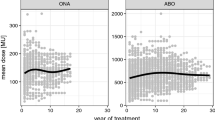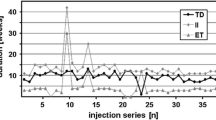Abstract
Botulinum toxin induced therapy failure type B antibody (BT–B, BT–B–AB) has so far only been reported after previous formation of antibodies against botulinum toxin type A (BT–A, BTA– AB).We wanted to explore the risk of BT-B-AB-induced therapy failure in patients who were exposed to botulinum toxin for the first time.
For this purpose we followed nine patients with cervical dystonia receiving BT-B (NeuroBloc®/Myo- Bloc™, Elan Pharmaceuticals) in a dose of 11435 ± 2977MU during 4.9 ± 3.0 injection series. All patients showed a satisfactory initial therapeutic response as documented by a Toronto Western Spasmodic Torticollis Rating Scale score reduction from 17.7 ± 9.4 to 5.3 ± 4.8 and an overall subjective improvement of 56.1 ± 28.3%. Seven patients experienced systemic anticholinergic side effects. Five patients had stable therapeutic responses over subsequent injection series. Four patients experienced complete therapy failure with BT–B–AB titres in excess of 10mU/ml on the mouse diaphragm assay. Doubling the last effective BT–B dose produced neither therapeutic effects nor side effects. Subsequent applications of botulinum toxin type A produced a continued therapeutic response in one patient and complete therapy failure in the other.
Despite the small sample size a frequency of 44 % indicates a high risk for BT–B–AB-induced complete therapy failure. The high amount of neurotoxin administered when NeuroBloc®/MyoBloc™ is used might be a contributory factor. Further prospective comparative studies are necessary to monitor the frequency and time course of BT–B–AB formation.
Similar content being viewed by others
References
Tsui JK, Eisen A, Mak E, Carruthers J, Scott A, Calne (1985) DBA pilot study on the use of botulinum toxin in spasmodic torticollis. Can J Neurol Sci 12:314–316
Jankovic J, Schwartz KS (1991) Clinical correlates of response to botulinum toxin injections. Arch Neurol 48:1253–1256
Anderson TJ, Rivest J, Stell R, Steiger MJ, Cohen H, Thompson PD, Marsden CD (1992) Botulinum toxin treatment of spasmodic torticollis. J R Soc Med 85:524–529
Zuber M, Sebald M, Bathien N, de Recondo J, Rondot P (1993) Botulinum antibodies in dystonic patients treated with type A botulinum toxin: frequency and significance. Neurology 43:1715–1718
Greene PE, Fahn S (1994) Response to botulinum toxin F in seronegative botulinum toxin A-resistant patients. Mov Disord 11:181–184
Jankovic J, Schwartz K (1995) Response and immunoresistance to botulinum toxin injections. Neurology 45:1743–1746
Dressler D, Rothwell JC, Bigalke H (2000) The sternocleidomastoid test: an in-vivo assay to investigate botulinum toxin antibody formation in man. J Neurol 247:630–632
Brashear A, Lew MF, Dykstra DD, Comella CL, Factor SA, Rodnitzky RL, Trosch R, Singer C, Brin MF, Murray JJ, Wallace JD, Willmer-Hulme A, Koller M (1999) Safety and efficacy of Neuro- Bloc (botulinum toxin type B) in type A-responsive cervical dystonia. Neurology 53:1439–1446
Dressler D, Benecke R, Bigalke H (2003) Botulinum toxin type B (Neuro- Bloc® in patients with botulinum toxin type A antibody-induced therapy failure. J Neurol 250:967–969
Consky ES, Basinski A, Belle L, Ranawaya R, Lang AE (1990) The Toronto Western Spasmodic Torticollis Rating Scale (TWSTRS): assessment of validity and inter-rater reliability. Neurology 40(Suppl 1):445
Dressler D, Lange M, Bigalke H (2004) Detecting neutralising antibodies against botulinum toxin type B with a mouse diaphragm assay. Mov Disord 19(Suppl 9:S105
Goschel H, Wohlfarth K, Frevert J, Dengler R, Bigalke H (1997) Botulinum A toxin therapy: neutralizing and nonneutralizing antibodies–therapeutic consequences. Exp Neurol 147:96–102
Dressler D, Benecke R (2003) Autonomic side effects of botulinum toxin type B treatment of cervical dystonia and hyperhidrosis. Eur Neurol 49: 34–38
Dressler D (1997) Botulinum toxin therapy failure: causes, evaluation procedures and management strategies. Eur J Neurol 4(Suppl 2):S67–S70
Kessler KR, Skutta M, Benecke R (1999) Long-term treatment of cervical dystonia with botulinum toxin A: efficacy, safety, and antibody frequency. German Dystonia Study Group. J Neurol 246:265–274
Jankovic J, Ahsan J, Vuong KD (2002) Comparison of immunogenicity of old versus current BOTOX in cervical dystonia. Naunyn Schmiedebergs Arch Pharmacol 365(Suppl 2):R25
Setler P (2000) The biochemistry of botulinum toxin type B. Neurology 55(Suppl 5):S22–S28
Health and Human Services, Public Health Service, Food and Drug Administration, Center for Biologics Evaluation and Research, Division of Clinical Trial Design and Analysis (2000) Myo- Bloc: Summary Basis of Approval Cervical Dystonia. Supplemental Clinical Review. Available from US Government through Freedom of Information (http://www. fda. gov/cder/biologics/pr oducts/botelan12800. htm)
Dressler D (2000) Complete secondary botulinum toxin therapy failure in blepharospasm. J Neurol 247:809–810
Dressler D (2004) New formulation of BOTOX®: Complete antibody-induced therapy failure in hemifacial spasm. J Neurol 251:360
Dressler D, Dirnberger G (2000) Botulinum toxin therapy: Risk factors for therapy failure. Mov Disord 15(Suppl 2):51
Dressler D (2002) Clinical features of secondary failure of botulinum toxin therapy. Eur Neurol 48:26–29
Dressler D, Muenchau A, Bhatia KP, Quinn NP, Bigalke H (2002) Antibody induced botulinum toxin therapy failure: Can it be overcome by increased botulinum toxin doses? Eur Neurol 47: 118–121
Author information
Authors and Affiliations
Corresponding author
Rights and permissions
About this article
Cite this article
Dressler, D., Bigalke, H. Botulinum toxin type B de novo therapy of cervical dystonia. J Neurol 252, 904–907 (2005). https://doi.org/10.1007/s00415-005-0774-3
Received:
Revised:
Accepted:
Published:
Issue Date:
DOI: https://doi.org/10.1007/s00415-005-0774-3




